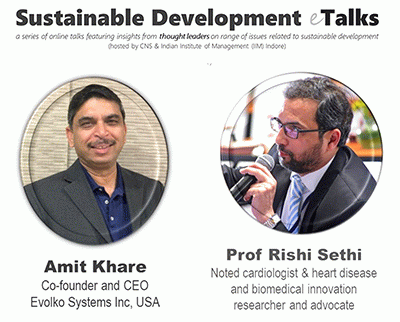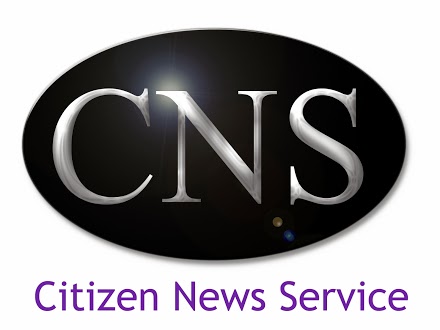
Prof Rishi Sethi, senior cardiologist from India and Amit Khare from US were keynote speakers for #SDGtalks on artificial intelligence and machine learning based solutions for healthcare problems
(Image by CNS) Details DMCA
Technology is often seen as a bane that impedes human ability rather than benefit it. We have seen the cost of our advancement in the increasing rates of deforestation, the rise of global warming and the absolute carelessness with which we treat nature. The increase in awareness has led to people becoming more environmentally conscious, yet, understandably, we cannot compromise the development of countries as technology keeps advancing. And in the same way, we cannot cause any more degradation to the environment for the advancement of technology or development. However, in light of recent events, it is perhaps the technology that will help us emerge from the pandemic unscathed to a more considerable extent. The Guardian recently reported that this destruction of the environment is causing pathogens to reduce boundaries between humans and animals.
In the Sustainable Development e-Talks (#SDGtalks) series, hosted by Indian Institute of Management Indore and CNS, Professor (Dr) Rishi Sethi, a noted cardiologist and biomedical researcher and Amit Khare, the co-founder and CEO of Evolko Systems shared their insights on how Artificial Intelligence and Machine Learning solutions can address the challenge of healthcare around the world. These technologies might be a ray of hope that might leave us better equipped to deal with situations such as these, unlike our predecessors who lacked the same when they dealt with such a crisis. Health professionals who have not yet embraced the resources available are likely to understand their enormous potential and making the improvements and adjustments needed for simplifying operations, lowering costs, enhancing efficiency and above all increasing the standard of treatment.
The idea behind this is the need to reduce human interaction, especially in the current scenario, to diagnose and treat people. This ensures that doctors are relied upon, only when necessary in times of emergency and also reduces the risk of contracting the illness due to exposure in a hospital, hence reducing the spread to a significant extent. Even in the case of surgeries, robotic aid is often to minimize human error. "We can have robotic surgeries, where the operator and the team sit outside the OT and perform the procedure with the help of a console. Thereby again, limiting the entire team being exposed to the patient on the table" says Prof Rishi Sethi in #SDGtalks (www.bit.ly/sdgtalks).
Amit Khare, on the other hand, believes that Artificial Intelligence, along with Machine Learning, can be used to treat issues that are non-communicable as well. This reasoning is because most treatment is episodic. He goes on to say, "And because of the episodic treatment, there is no focus on identifying the non-communicable diseases (NCDs), which are becoming the leading cause of death (over 70% deaths globally are because of NCDs). Nevertheless, the doctors to patient ratio is another issue, especially in India. The WHO recommends a proportion of 900 patients or below for one doctor, but in India, the proportion is approximately 1700 patients to one doctor."
And the ratio would not go down anytime soon as a nation cannot drastically increase (practically double) the number of doctors in a decade. Many of these diseases require specialists who are even rarer. This problem, they believe, can only be solved with the help of technology. This made them come up with this idea which employs data-based decision making and asynchronous communication to save the vital time of both doctors and patients by an impressive 30%.
An example of how technology is being used is, suppose a patient comes with chest pain. The software will ask whether the chest pain is with or without exertion in an attempt to find more relevant details. So, these questions decide how the diagnosis and the treatment will proceed. Then the software would like to know if the pain is radiating or something and suppose the patient said, "Yes. From the left shoulder." Since this is very common in chest pain people, the software will conclude that the left side implies a heart-related issue. The software tries to find out whether it is related to the shoulder or it related to chest pain, it could raise your hand, and that means it's ruling out the problems with the shoulder. After all, if the person can raise his/her hand, then it's good, if it is not, the software will try to find out whether this is because of the pain, stiffness of the weakness, or anything else because each symptom has a connotation only a specialist can understand. These are all very relevant questions. And they generally go through these. So, once the specialists figure them out, they can draw accurate conclusions, "The patient is suffering chest pain because of the shoulder." The software continues and tries to find out more details from the patient to see whether it's like any other non-communicable disease that can be screened during the interaction with the patient. And that's a very precious interaction, as much information should be discovered during this so that the software can then refer it to the doctor.
The proponents of this technology, i.e., researchers and doctors who made use of them, reported that the patients informed an astounding 94% improvement in the quality of care. Amit Khare informed that, "A study conducted by Harvard University revealed that about 70% of the patients don't remember their interaction with the doctor, and this software helps keep track of it. The patients also felt that they were being heard in more detail, and they felt more at ease while providing the information. This ultimately helps in faster and better diagnosis. As of now, about 8 million patients are using this technology, and they expect this number to increase multi-fold in the future."
The technology employs asynchronous communication to save the time of both doctors and patients. Amit Khare further says that "One of the key things that technology has done these days and you all would agree, is if we today, we have to meet like about 100 people, it will be next to impossible. And, but we can reply to all hundred people using WhatsApp or email which are the asynchronous means of communication and that we can deal with those 100 messages within an hour or so. So that's, that's the advantage of asynchronously working."
(Note: You can view every article as one long page if you sign up as an Advocate Member, or higher).





